On May 5, Denmark will once again commemorate the end of the German Occupation during World War II. This year’s anniversary will have an added poignancy as it is now fully 70 years since the invaders left.
But as the country marks the moment on May 5, it is worth questioning whether the Danish people are celebrating their liberation on the correct day.
The Nazis actually surrendered to the Allies in the Netherlands, the northwestern part of Germany and Denmark on the evening of May 4 – to Field Marshal Montgomery at 6:30 at Lüneberg Heath in Germany, and the news quickly leaked through to Danes listening on their radios.
The British were heading for Copenhagen, but wouldn’t arrive until the next day. It was a window of opportunity that some Danes would find hard to resist. Little did they know that some had already got a headstart.
Under the floorboards
Michel Pascual, a resident of Vesterbo, was one of many Copenhageners to sustain damage during last year’s extreme rainfall. A malfunction in his building’s drainage led to gallons of water entering his apartment via an air duct.
He had no choice: he would have to pull up his wooden floor and relay it. Underneath an awfully big surprise was waiting.
Pascual discovered a huge pile of newspapers from the early 1940s. Mostly consisting of supplements aimed at the Nazi-occupied housewife (‘How to get bloodstains out of your carpet’ etc), his eyes were drawn to the headline “Berlin er faldet” (Berlin has fallen).
The date of the Politiken newspaper read 4 May 1945, and the contents of page 3 made very interesting reading indeed. It would appear that retribution was already well underway by the time the German surrender was announced.
A one-day free pass
“This is London …” announced the BBC Danish broadcast at 8:30pm on May 4.
“At this moment, it is announced that Montgomery has stated that the German troops in the Netherlands, Northwest Germany and Denmark have surrendered.”
The message was relayed by Johannes G Sørensen, the same announcer who told the Danes their country had been occupied on 9 April 1940. He later fled to the UK in 1944.
Those listening were informed that the German surrender would not officially take effect until 8am on the following day. With the British expected later that day – a relief to many, as it was feared the Soviets might try to take Denmark to take control of the Baltic Sea – a final night of the Occupation beckoned.
But for many, it was already old news. The streets, for so long the domain of the soldiers, had been theirs for the taking for several days – particularly as there were no officers of the law as the Danish police force had been dissolved in 1944. Many Danes had already been busy: not celebrating, but exacting vengeance.
Retribution was swift
There were more reported deaths in Denmark between January and May 1945 (1,531) than there were in the four years prior (1,154).
As page 3 of Politiken on 4 May 1945 reveals (see photo), revenge was bloody and swift as Danes perceived to be traitors were sought out by their countrymen and summarily executed.
It’s interesting to note that none of the stories are reported as retribution against Nazi collaborators, but it’s safe to assume that was the case.
More of the same then followed on May 4 and 5 as suspected Nazi collaborators, stikkere (moles), were rounded up, while many of the women, who were mostly accused of sleeping with Germans, were publicly humiliated. Some were even stripped naked and daubed with swastikas.
In total, 40,000 were rounded up, of which 13,500 were eventually punished for collaborating with the enemy.
Post-war post-script
On May 5 at 4:32 pm, the first Allied troops under the leadership of General Richard Dewing arrived in Copenhagen (Montgomery didn’t arrive for another week). It marked the start of a long-lasting friendship with the British – the warmth of which is still felt today.
The Danes were right to fear the Soviets. They bombed Rønne and Nexø on the island of Bornholm on May 7-8 before occupying the island on May 9. Bornholm wasn’t liberated until 5 April 1946 – a month short of the first anniversary of Denmark’s liberation.
While May 5 has been remembered as Liberation Day (Befrielse Dag) ever since by the Danish public, May 4 is actually remembered too.
Many light candles by their window to commemorated the end of the blackouts, and there’s an annual ceremony at Mindelunden in Hellerup, where fallen Danish soldiers are laid to rest.
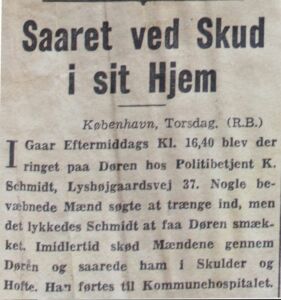
Vice President of Engelbert-Petersens Bagerier, C. Engelbert-Petersen, took a taxi to his home in St Kongensgade via Østerbrogade on Tuesday evening (1 May 1945, ed) as a car further ahead was shot at. A stray bullet hit Engelbert-Petersen who was admitted to Kommunehospitalet (now City Campus, ed) shortly after.
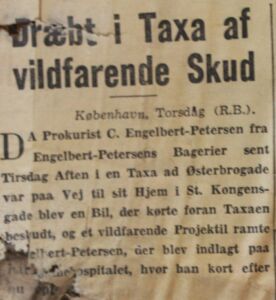
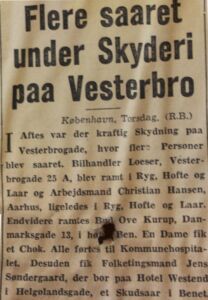
Yesterday evening heavy shooting occurred at Vesterbro injuring several people. Car dealer Loeser from Vesterbrogade 25A and worker Christian Hansen from Aarhus were both hit in the back, hip and thigh. Furthermore, messenger Ove Kurup from Danmarksgade 13 was hit in the right leg. Along with a woman suffering from shock, they were taken to Kommunehospitalet. Additionally, MP Jens Søndergaard, who is staying at Hotel Westend in Helgolandsgade, received a gunshot wound to the leg.
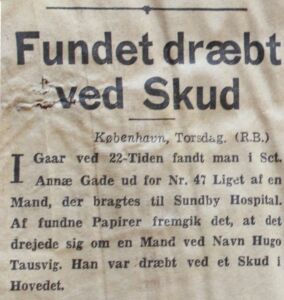
Yesterday at 10 pm outside Sct. Annæ Gade 14, the corpse of a man was discovered and then taken to Sundby Hospital (now Amager Hospital, ed). Papers found uncovered that his name was Hugo Tausvig. Cause of death was a shot to the head.
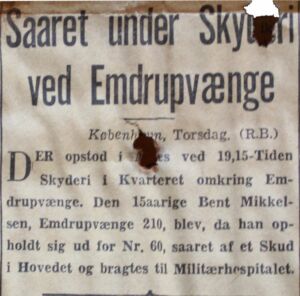
Yesterday evening at around quarter past seven, shooting occurred in the neighbourhood surrounding Emdrupvænge. 15-year-old Bent Mikkelsen from Emdrupvænge 210 was wounded by a shot to the head while standing outside number 60. He was taken to Militærhospitalet (now Rigshospitalet, ed).

Yesterday afternoon at 4:40 pm the doorbell rang at the residence of police officer K Schmidt, Lyshøjgaardsvej 37. Some armed men attempted to enter the premises, but Schmidt managed to shut the door. The men shot through the door, however, and wounded his shoulder and hip. He was taken to Kommunehospitalet.












